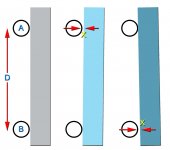Bugsysiegals
Member
- Joined
- Mar 19, 2016
- Messages
- 909
Wood Peckers squares are spec'd to have an accuracy of within 0.001" over 12". It would be nice to know the maximum "theoretical" accuracy a given set a bench dogs (19.90mm vs 19.98mm) "could" produce assuming perfect 20.00mm dog holes, dogs seated perfectly, etc.
I assume accuracy would be measured using 2 dogs positioned 12" apart horizontally and 2 dogs positioned 12" apart vertically but am not sure it's as simple as doubling the amount of "play" they have to account for horizontal/vertical movement since there's 4 end points involved.
So, for those of you who are more technical savvy in this area, how do you calculate this?
I assume accuracy would be measured using 2 dogs positioned 12" apart horizontally and 2 dogs positioned 12" apart vertically but am not sure it's as simple as doubling the amount of "play" they have to account for horizontal/vertical movement since there's 4 end points involved.
So, for those of you who are more technical savvy in this area, how do you calculate this?

